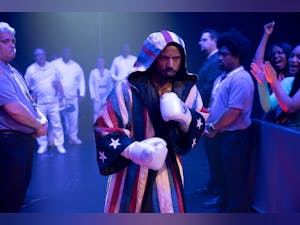From: Silver Screen
REVIEW: ‘The French Dispatch’ is Wes Anderson at his most self-referential

Chock full of bright colors, whimsical plotlines, a familiar cast of characters and pristine technical direction, “The French Dispatch” is undeniably a Wes Anderson film.
With an absolutely stacked cast, Anderson takes viewers through the final edition of The French Dispatch, a mid-20th-century offshoot of a fictional magazine in Kansas written by a team of expatriate journalists in the fictional French town of Ennui-Sur-Blasé, following the sudden death of the editor, Arthur Howitzer Jr. (Bill Murray).
Anderson has been steadily churning out projects since the late 1990s, and it feels like everything in his twenty-year oeuvre has led him here. As a result, Anderson’s strengths and weaknesses are magnified; “The French Dispatch” is a meticulously crafted world that often resembles a dollhouse of sorts due to Anderson’s technical composition. The director’s style, however, is larger than life, sometimes domineering over the emotional depth of the characters and plotlines.
“The French Dispatch” is, above all, an ode to storytelling. We learn that most of the edition was finished before Howitzer’s death, so we see the editor presiding over the writers, with acute attention to detail and a penchant for speaking in maxims. The film is then structured through the articles that make up the dispatch, each one narrated by the journalist who writes it and the distinct ways that come with their telling of their stories.
The first story, a travelogue by Herbsaint Sazerac (Owen Wilson), follows Sazerac on a bike ride through Ennui. Sazerac is interested in the seedy underbelly of the town and documenting the decay of society, which leads to some classic slapstick comedy moments. The briefest narrative of the film, Sazerac sets the stage for the stories to come.
Next, we’re brought to an auditorium as J.K.L. Berenson – a caftan-wearing Tilda Swinton with a Transatlantic accent – presents “The Concrete Masterpiece” to the crowd, a story about the advent of modern art. From here on, the film frequently switches between black & white and color with no apparent rationale. As Berenson orates, we meet the artist Moses Rosenthaler (Benicio Del Toro) as he paints his muse (Léa Seydoux). It’s only once Rosenthaler finishes his painting that Anderson reveals Del Toro to be a prisoner and Seydoux, his guard. The gruff and unhinged Rosenthaler meets Julian Cadazio (Adrien Brody), an art dealer looking to discover the next genius of the art world.
The third article, helmed by Frances McDormand as Lucinda Krementz, is one of the few stories where the journalist isn’t the only narrator. Krementz, while reporting on youth revolutions, begins a relationship with Zeffirelli (Timothée Chalamet), a timid yet endearing young radical. With a few tongue-in-cheek remarks about the illusions of objectivity, Krementz helps Zeffirelli write his manifesto and doles out advice to the protesters. Zeffirelli’s own narration is interspersed in the story and as he takes over, the style drastically changes from Krementz’s straightforward black and white storytelling to vibrant colors and animations that match Zeffirelli’s charismatic monologues.
The final full story is perhaps the most compelling of the four. A piece for the Dining section, we meet the James Baldwin-esque writer Roebuck Wright (Jeffrey Wright) as he’s being interviewed for a television show in the future. He recites the article, a profile of a prominent chef (Steve Park) that barely mentions the chef at all. Instead, Wright focuses on the kidnapping of a police chief’s son, which the chef just happens to be wrapped up in. Not only is this story the most emotionally poignant of the set, but Wright delivers a standout performance among a phenomenal cast. He holds his weight against Anderson’s style, providing the most depth of all the narrators through heartfelt wit. This vignette also stands out from the rest through a drastic change in style; a car chase scene is done through a charming comic strip-like animation.
We’re brought back to the beginning as the writers gather to finalize the magazine, but are instead met with the death of their beloved editor. No time to mourn – and a strict “no crying” policy – the final article of The French Dispatch is an obituary that the team writes together.
The film covers a lot of ground, but because the storytelling is so neat, it doesn’t feel like Anderson left any stories incomplete. There’s an aloof quality to Anderson’s characters, which sometimes reads as a lack of emotional depth – it’s unclear whether this is Anderson falling prey to “style over substance” accusations, or just a necessary consequence of having idiosyncratic magazine articles come to life.
Ultimately, “The French Dispatch” is eccentric, irreverent and all the things that we know a Wes Anderson film to be. More than anything, it’s a good time, which is what we all need these days.
“The French Dispatch” was released in theaters Friday.




